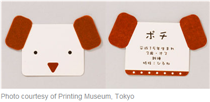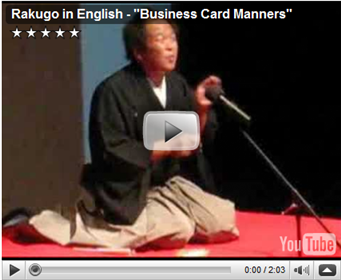Japan: Everything You Need to Know About Business Card ‘Meishi’ Etiquette
Deborah Swallow | August 22nd, 2009 in : cross-cultural communication, East Asia, General, working internationally
For those in Asian countries, the exchanging of 
business cards is symbolic; it symbolises the beginning of a relationship. In Japan, meishi koukan is so important they even have an etiquette for it. If travelling to that part of the world, ensure that you have a vast amount of cards with you (read below to understand why) as people formally present cards at the beginning of every first meeting. This is exceedingly important if you are on an extended business trip.
Read the tips below to understand what is involved with business card etiquette and then watch the selection of videos that I’ve come across online that teach the novice how to exchange a card. If the card exchange goes badly, well… not much hope for any successful business relationship in the future!
In this part of the world, your business card represents your social status. Unless a business card has been exchanged, no business can take place. If you do not have one, this implies you are of no consequence; you don’t exist.
While business cards can serve an important networking function in Japan, the primary function of the meishi is to be an emissary of the owner, the body’s paper envoy preparing the grounds for exchange with the precise written instructions of how its owner must be treated. While the English term ‘business card’ is merely a bland description, the Japanese term ‘meishi’ contains two characters which literally mean ‘point at the name’. If the Western business card is something meant for future reference, the Japanese meishi is a way of smoothing communication by revealing one’s true status.”
David Willoughby
So, what is the etiquette?
- Business card etiquette starts with the layout of the actual business card itself, which should be printed in Japanese and in English (or your language) – perhaps one on each side.
- The standard sized meishi is 55 x 91 mm. Every little detail that can be adjusted to create a different impression generally is: the texture of the card itself, whether warm and fibrous with rounded edges or crisp and clinical with razor-sharp corners, can speak volumes about the name on the card. No detail here is considered too small for improvement.
- Corporate names on cards grant status. Freelanceers and entrepreneurs therefore need to be creative and tend to overcompensate with extravagant concepts to grab your attention: peculiar shapes, unusual textures, folding designs, cellphone-readable barcodes.
- Be innovative about the design- the Japanese are – they are joyously and earnestly creative and have a meishi for any excuse. They are totally unaffected by the classical self-censorship that we in the west usually refer to as reason or common sense. So there’s a meishi for your baby, a meishi for your dog. A meishi that can be totally immersed in water but doesn’t go soft. Fold-out, pop-up meishi displaying festive scenes. A meishi that can be reassembled as buttons for your shirt. A meishi made of nori seaweed. A planetarium meishi that when viewed in total darkness displays the constellation of The Plough in tiny lights. Make your card memorable!
Now, to how to give your card…
Video Link:
embedded by Embedded Video
YouTube Direkt
- You need to know your social status in comparison to the social status of your opposite as this will establish how deeply and how long you should bow for. Factors that have an influence on your status include age, nationality, your sex and employments status.
- If you have made the decision that you are lower in ranking, you should make the initial step and offer your card first.
- If you are of lower rank then you not only bow lower and longer, but your business card should be offered at a lower level (underneath) your counterpart.
- Business cards are given to the most important member of the team first, and then passed to others in descending order of the hierarchical status.
- Never exchange business cards with someone to whom you have previously given a card – this can be interpreted as an insult – you imply that you have forgotten about him/her so they are not important to you. You have made them lose FACE.
- Present the card with the other person’s language face up – and the correct way round for them to be able to read. (Handy tip: if printed in a script you cannot read ensure there is a symbol in a corner that signifies to you which is the right way up. This helps if you need to hand over many cards in a meeting – you can see it quickly without any effort).
- Never casually offer your card with just one hand. Hold your card with both hands when you give it
- Bow as long and as low as befits your station – being foreign, young, female, and/or unaffiliated with a corporation means you must bow very, very low.
- Receiving a business card should be done in the same way, but bow even longer and lower than you did before. Say thank you, or ‘Hajimemashite,’ (meaning ‘Nice to meet you’) as you accept it with both hands.
- Study the business card intently, even if you can’t read a single line. At the very least, remember the giver’s name. They WILL remember yours!
- Place it away carefully in your bespoke business card holder as though you have been given a valuable piece of art.
- NEVER write on it.
- In a meeting, place the cards on the table before you and leave them there – possibly for the whole duration of the meeting.
- Finally, even the Japanese themselves see the funny side of their strict etiquette as demonstrated by this Rakugo comedy:
Video Link:
I got this following story from David Willoughby, a freelance writer now living in Tokyo:
Whilst in Japan, I happened to find myself seated next to another foreigner who recognised me from the gallery event we had both just attended. We chatted amicably for a while … A little while later, he stood up to leave. “If you like art,” he said to me, almost as an afterthought, “you might be interested in this.” And he nonchalantly tossed onto my table his business card on which he had biro’d the details of some upcoming event he was attending.
It wasn’t just the contrived nature of his networking spiel that made the exchange so unforgettable, it was in the small details. It was in the way in which he dealt his card onto the table rather than to me directly, minimising the chance that it might be rejected. It was in the fact that he waited until the final seconds of our encounter to produce it so that neither of us would have to endure the awkwardness of the moment. Before I had a chance to digest what was written on the card he had vanished.
The exchange would have been amusing for any watching Japanese who are, of course, far more comfortable with the use of business cards, or ‘meishi’. In the West, business cards are strictly for networking and careful consideration must be made about if and when to proffer the card – not so in Japan.
“Sayonara!” I hope you’ve found this helpful!
Find more information about cross cultural differences in the exchange of business cards by clicking on the following links:
Top Ten Tips on passing business cards with cultural fluency
Japan: everything you need to know about business card ‘meishi’ etiquette
U.S., Britain, Australia: Business Card Etiquette
The art of business card giving: an East West perspective

Tags: business card etiquette, cross-cultural communication, Japan, Japanese business card exchange, meishi, standard sized business card japanese, top business tips Japan


 Hello, I'm Deborah Swallow and, for the last fifteen years, I've worked in over thirty countries addressing the complexities of people working internationally across multiple cultures, so individuals and organisations alike can gain an authentic competitive edge and win in international markets.
Hello, I'm Deborah Swallow and, for the last fifteen years, I've worked in over thirty countries addressing the complexities of people working internationally across multiple cultures, so individuals and organisations alike can gain an authentic competitive edge and win in international markets. 
I still haven’t any cool business cards, so I am thinking if I should do them myself or leave it to a professional designer. What do you guys think?